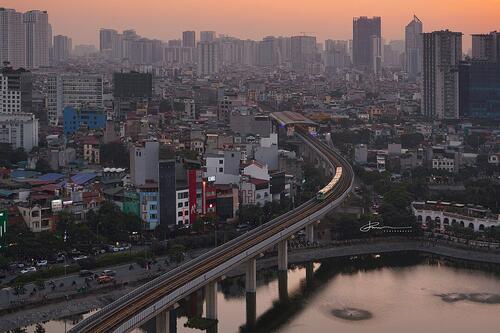The Future of Hanoi Rail

The Future of Hanoi Rail

The planned 10-line Hanoi Metro. Currently, only Line 2A is operational. Credit: Hanoi Metro.
Hanoi’s rail network currently consists of only one operational line—Line 2A, the Cát Linh–Hà Đông line—out of ten planned. The Cát Linh line, which began construction in 2008 and originally slated to open in 2013, began operations only in November 2021. The Nhổn–Hà Nội Line (Line 3) is currently the only other line under construction, and operations are expected to begin in 2027. After fifteen years, Hanoi’s public rail infrastructure is a shell of what it promises to be. So what gives?
In a recent interview with The Hanoi Times, Hanoi Metropolitan Railways Deputy Director Le Trung Hieu explained some of the obstacles preventing rail transit expansion in the city.
According to Hieu, chief issues include insufficient funding and regulatory red tape. Hanoi’s rail transit construction relies heavily on foreign investment—the Cát Linh line’s $868 million price tag was financed with $669 million in Chinese loans—and attracting investors requires the construction of relatively unprofitable ‘model lines’ running through central urban districts. Hieu also claims that land clearance is a major issue, as rail construction necessitates the seizure and compensation of households along planned routes. For solutions, Hieu argues that the Hanoi People’s Committee should delegate regulatory power to develop clearer guidelines for railway developers.
Rail systems are an essential component of public transit in cities throughout the world. Unencumbered by roadways, they function as arterial connectors in a way that bus systems struggle to match. Developers in cities across the world have begun setting their sights on transit-oriented developments (TODs), a type of development which, according to Infrastructure Asia, “maximises residential, commercial and entertainment space within walking distance of public transit nodes,” as a means of increasing quality of living. TODs typically cluster around a single node, with smaller, more walkable block sizes than automobile-oriented developments. When TODs are connected via rail, the results are promising: Singapore’s transit system is known for doing just this, resulting in “a constellation of satellite towns that surround a central core, with rail networks that link these towns to industrial parks and the city centre.”
The State Appraisal Council recently approved funding for the construction of the Văn Cao–Hòa Lạc line, which is planned to follow a TOD model. Hieu claims that the Cát Linh line, by comparison, is relatively unconnected to the overall mass transit network and is ineffective as a result. He argues that further rail construction will catalyze demand and stimulate development, a concept known as “induced demand.”
Hieu is right to point out that rail development (and transit development generally) doesn’t exist in a vacuum. Jakarta learned this the hard way after constructing the world’s longest bus rapid transit system, which failed to attract significant ridership numbers. The problem? A city layout developed by colonial authorities, built to serve private (not public) transport. Jakarta has responded in recent years by planning several TODs; Hanoi may do the same. Rail development, in its ideal form, is not a graft onto an already painted canvas. It is a reimagination of how we live in cities.
Sources
https://www.railjournal.com/passenger/metros/hanoi-opens-vietnams-first-metro-line/
https://research.hktdc.com/en/article/MzE4MDM3MjUw
https://www.infrastructureasia.org/insights/transit-oriented-development
https://en.baochinhphu.vn/capital-to-build-van-cao-hoa-lac-metro-line-111230926092347499.htm
https://papers.ssrn.com/sol3/papers.cfm?abstract_id=3791821
https://hanoimetro.net.vn/en/ban-do-8-tuyen/ (Image credit)